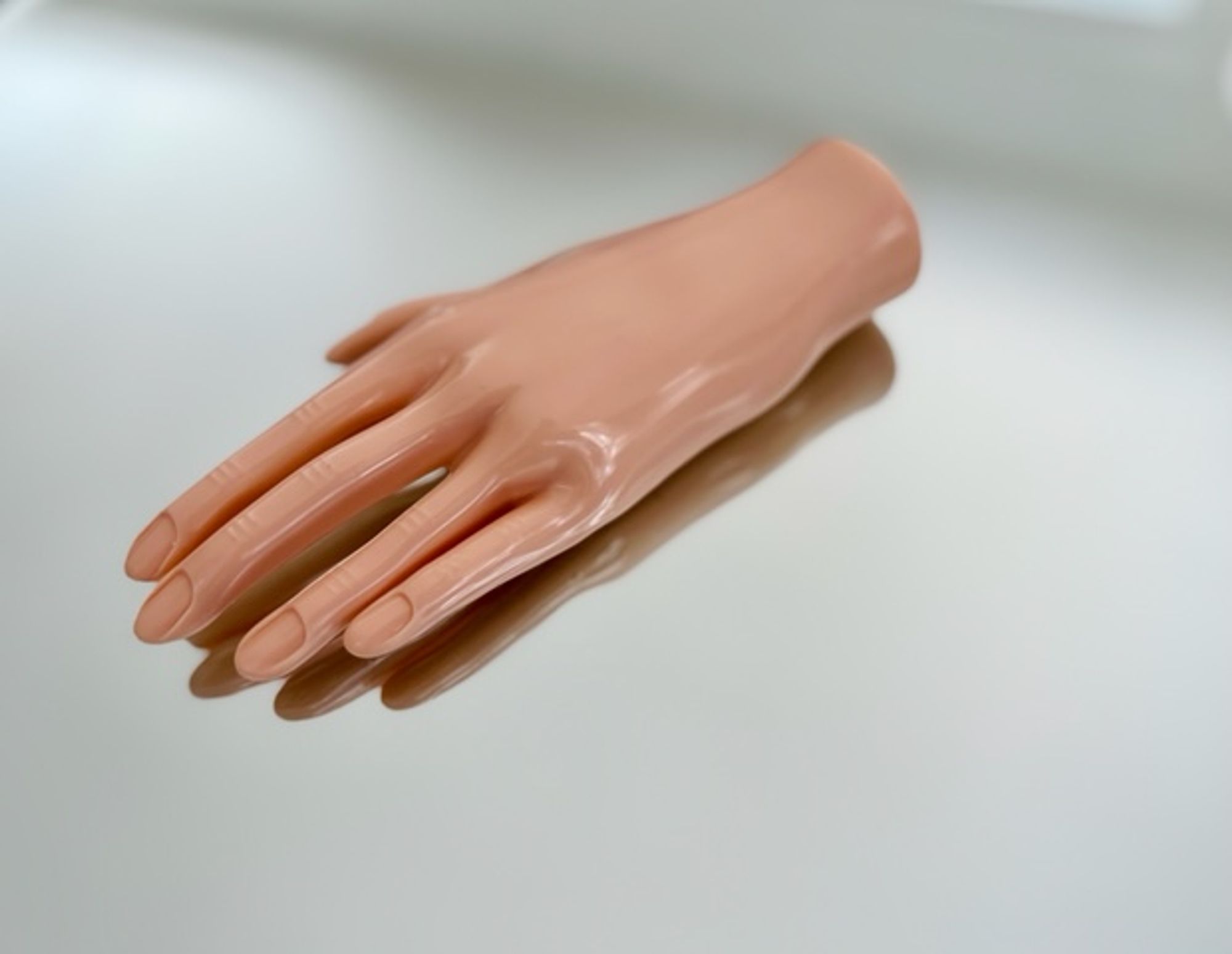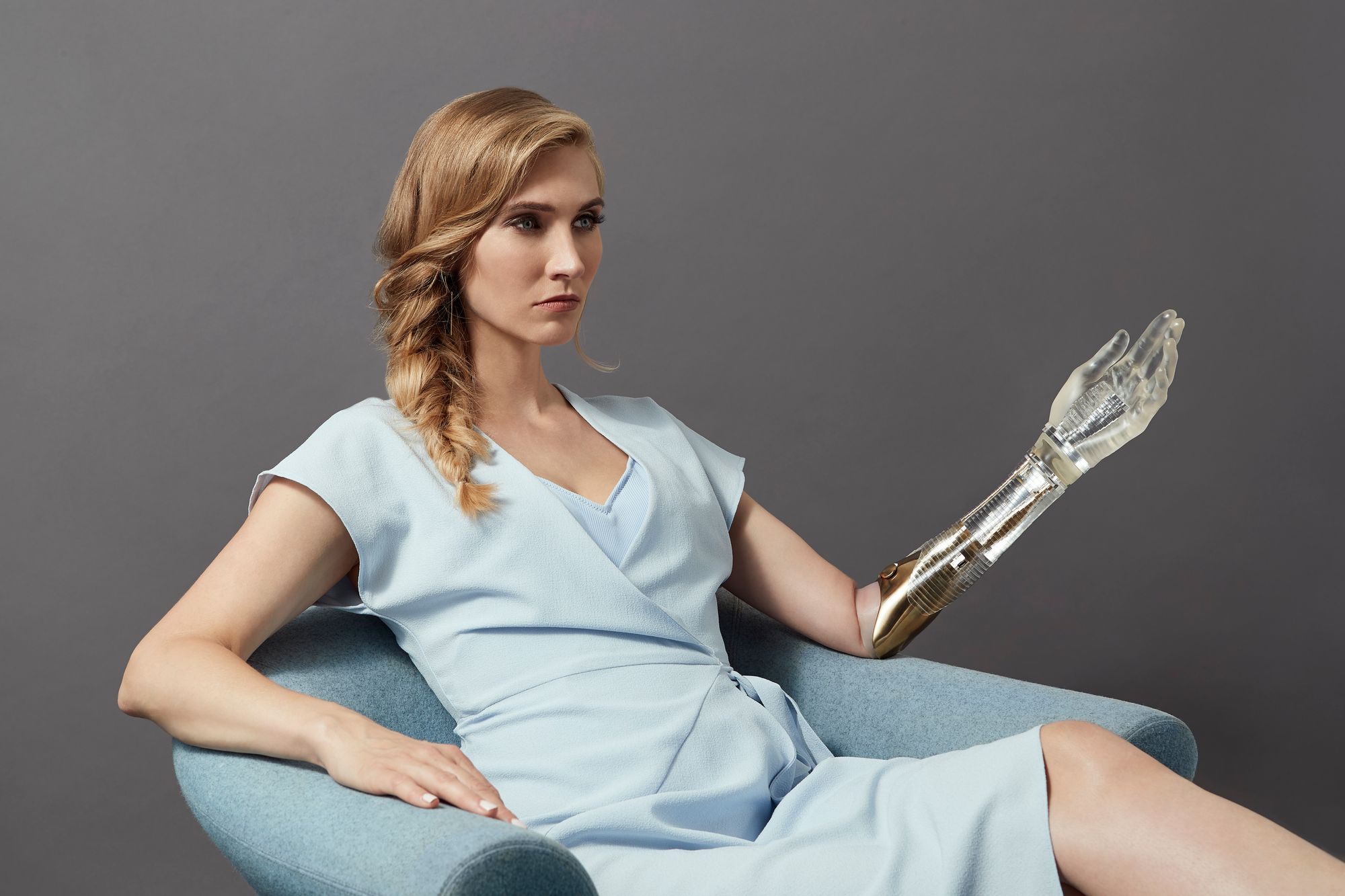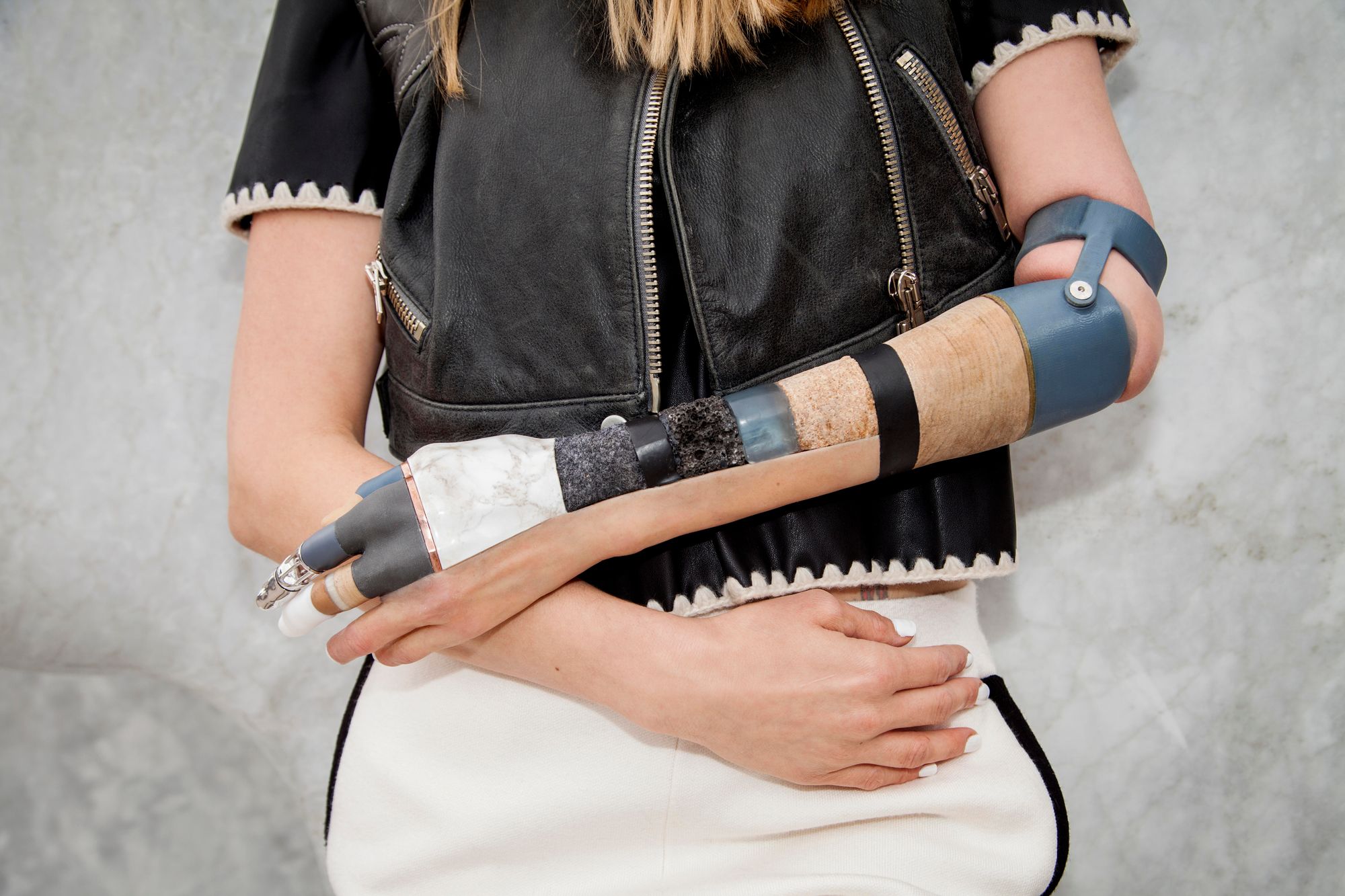The Invisible Hand
I bought the rubber hand at a beauty supply store. It’s a delicate, porcine pink. The rubber is dense and slightly malleable; its slender fingers are frozen in a dainty gesture, as if shyly outstretched to a suitor. It’s smaller than my own hand, but for the sake of this experiment, it’ll do.
At home, I wedge the rubber hand into the left sleeve of my sweater and place it on the table, parallel to my right hand. I slip my true left hand out of sight. My husband, conscripted into this experiment, sits facing me, holding two paintbrushes. Very carefully, he brushes the fingers of my left hand with one brush, and the fingers of the rubber hand with the other.
The illusion happens immediately. As I watch the brush graze the dummy hand, I can feel the sensation of bristles grazing the inanimate rubber. Intellectually, I know it’s not my hand. I know I bought it, for nine dollars, that afternoon. But that doesn’t matter. The sensation is beyond logic, pinging some slumbering part of my brain: that rubber hand is mine. I feel it.

In neuroscience, as in philosophy, sometimes the simplest questions are the most difficult to answer. The “rubber hand illusion,” first documented in 1998, left me with one such question: what makes my body mine? That is to say, when I look at myself in the mirror, how do I know that what I see is my body, rather than someone else’s, or just another object?
The French philosopher Frédérique de Vignemont has spent years examining the complex question of body ownership. In her 2017 book Mind The Body, she observes that although our bodies are inalienable, we spend most of our lives unaware of them. “The fact is that our body never leaves us and can thus become almost transparent,” she writes. Sensation—pain, pleasure, and the feeling of limbs crossing one another—can remind us of our bodies. But sensation alone doesn’t account for the experience of embodiment.
To make her argument, De Vignemont explores edge cases. People with somatoparaphrenia, a neurological impairment caused by damage to the right parietal lobe, experience their own limbs as strangers. These patients can feel sensation in a limb all while retaining their impression that it belongs to somebody else. They are, in a sense, mental amputees. Physical amputees, meanwhile, often experience “phantom” sensations in limbs that don’t exist. And finally there’s me, feeling sensation in a dummy hand. We may think the boundary around our own bodies is clearly drawn, but embodiment is surprisingly fluid.
De Vignemont is one of the rare philosophers to inform her conceptual analysis with empirical findings, seeking out “thought experiments that happen to be actual” in current neuroscience. She has plenty to draw from. The question of body ownership is a practical research problem, especially in assistive prosthetics. Nearly half of hand amputees choose not to use their prosthetic hands regularly. This is due in part to the limitations of the current technology, but many clinicians and engineers believe it is also due to a lack of embodiment. Often, prosthetics don’t feel like part of their users’ bodies. They’re tools, not limbs.
But what, exactly, is the difference? Perhaps that’s a question for a neuroscientist.

Dr. Tamar Makin is a neuroscientist at University College London’s Institute of Cognitive Neuroscience. Her lab, the Plasticity Lab, works with upper-limb amputees to study how the loss of a limb alters cognition. To further probe the relationship between prosthetics and the brain, Makin has recently begun to experiment with augmentative robotics.
In one recent study, Makin invited participants to wear a robotic “Third Thumb” created by the designer Dani Clode: a 3D-printed, bendable appendage that makes it possible, among other things, to open a jar single-handedly. In the study, participants learned to use the thumbs in the lab; they were also encouraged to take them home to play guitar, cook, and conduct other supernumerary experiments.
Less than a week after the introduction of the new finger, fMRI scans of the participants’ brains revealed that their natural body representation—the “mental picture” of their own hands in their motor cortex—had changed. As the first scans came in, Makin was stunned. With the addition of the new finger, their brains had changed the map. “With the first participants,” she remembers, “the finger maps in the brain looked so fundamentally different that I was like, ‘you have to bring them back, we have to scan them again and make sure that their hand representation is back to normal.’”
The brain’s map of the body is sometimes illustrated as a “cortical homunculus,” a representation of the human body with bulging eyes and mouth, outsized hands, and tiny, spindly legs—a somewhat grotesque representation of the different parts of the body’s relative importance to the motor cortex. The homunculus’ hands are massive because hands, Makin says, have “the best cortical real estate.” Which is why Makin was so surprised to see, in the fMRI scans of her participants’ brains, a changed neighborhood. Their fingers were collapsing into one another, as though they were being squeezed together to make room for the new thumb.
Fortunately the change wasn’t permanent. The participants only wore their extra thumb for five days, about four hours a day, and as the study progressed, the results were more modest. But much of the research in this domain, she tells me, is sponsored by those with an interest in maximizing the efficiency of repetitive tasks on the assembly line. She wonders aloud: what happens to a future factory worker kitted out with an augmentative device—say, an extra arm? After ten-hour work days, six days a week, their sense of their own bodies may not so easily revert to normal.
At the moment, we don’t know if humans can learn to operate an extra artificial limb without sacrificing control of their existing ones. People born with a sixth finger have dedicated “neural resources” to control that extra finger; in traditional prosthetics, freed-up resources, like the residual nerves in the arm of an amputee, can be used to control an assistive device. But augmentative devices add to the nervous system’s workload. Makin and her peers call it the “neural resource allocation problem,” the Achilles heel of the nascent field of augmentative robotics: how do we make room for extra limbs when the brain is already fully occupied with controlling the limbs we already have? As Makin’s research shows, extra fingers and hands may actually end up harming the very bodies they’re designed to augment.
Will this cognitive failsafe prevent us from ever becoming cyborgs? Makin asks me to check back with her in five years. “As far as I’m concerned, this is virgin ground, with beautiful virgin sandy beaches,” she says.
She winces a little, smiling. “And lots of quicksand too.”

Makin often turns to de Vignemont for help clarifying the essential questions of her research (“How lucky are we to have a philosopher to inform us?” she exclaims.) Recently, the pair have been talking about embodiment, and what precisely that means.
Their disciplines define it differently. In philosophy, embodiment is often discussed at the level of conscious experience—from Descartes’s Cogito Ergo Sum to de Vignemont’s own analysis of body ownership. In prosthetics, however, the term is more practical. A prosthetic is considered “embodied” if sensory information about it is processed by the nervous system in the same manner as it would for the missing limb, to accomplish the same ends. This is “hard” embodiment: a prosthetic hand that looks like a hand and works like a hand. As the thinking goes, the brain should perceive such a prosthetic as a hand. Makin thinks it’s more complicated.
The perfect hand is still beyond our grasp, so to speak. Even the most advanced hand prosthetics have latency issues and require extensive training to use effectively. Often, the wearer of such a device, unable to feel fully embodied, feels uncomfortable, even alienated. Some amputees prefer easier-to-control, “low-tech” devices—the winner of the 2016 Cybathlon, the first bionic Olympic Games, crushed his competition with a gripper hand—and some prefer to wear static hands, or none at all. For many congenital one-handers, wearing a prosthetic is seen as a social expectation, not a medical need.
“For many communities that could potentially benefit from prosthetics, a prosthesis is incredibly limiting,” Makin explains. Counterintuitively, she argues, we need to think beyond the body. The sensorimotor loops of our nervous system translate the input of sensory experience into motor responses, allowing us to experience and act upon the world. But these loops aren’t bound to the body as it exists; they aren’t, Makin writes, “doomed to function only with something that is exactly like a body and that performs the same functions as the body and in the same way.”
With Silvestro Micera, a biomedical engineer from the École polytechnique fédérale de Lausanne, Makin and de Vignemont recently published an innovative, cross-disciplinary paper proposing a “softer” approach to embodiment. They use airplanes as an illustration: rather than mimicking how a bird flies, airplanes abstract the principles of flight and put them to new use. In the same way that a plane is not a bird, the carbon-fiber “blade” legs of an Olympic runner are not literal legs, but an alteration that leverages some of the same principles.
Such “soft” embodiment may help prosthetic wearers feel more in tune with their devices. It may also help guide engineers around the neural resource allocation problem. Given the freedom to think beyond the body’s existing template to design advanced prosthetic and augmentative robotic devices, they may be able to co-opt existing computational bandwidth, “recycling” neural resources rather than overloading them.

Dani Clode’s desk is covered in thumbs.
She’s gone through 150-odd prototypes since she first premiered her groundbreaking augmentative device, The Third Thumb, as a graduate student at the Royal College of Art in 2017. Over the persistent whirr of her 3D printers, Clode tells me that there’s no easy way to categorize what she has built. “In my experience, it's none of the things and all of the things,” she states. “It's a tool, an experience, a piece of art, and a way to express yourself through fashion—as well as a body part.”
One of Clode’s closest collaborators, the model and disability advocate Kelly Knox, is congenitally one-handed. Knox avoids using prosthetics in her daily life; when she was a toddler, she once threw her prosthetic arm out the side of her stroller in the post office. “It was never part of me,” Knox explains. “Not real, just fake, hard, ugly, orange, impractical, heavy.” When she was older, she scribbled all over her prosthetic arm, in rebellion. The world saw her as incomplete, but she wasn’t missing anything; she was whole.
For Knox, Clode has designed a number of conceptual prosthetics: an arm of clear acrylic and gold clockwork, which keeps time to her heartbeat; an arm built from interchangeable blocks of steel, rock, earth, wood, bronze, and moss; and a green “vine arm” that coils and unfurls like the tendril of a living plant. Knox delights in these “alternative limbs,” which are the opposite of traditional prosthetics. Rather than conceal a societally-perceived lack, they celebrate her difference and add something new. “They are art, fashion, full expression, an extension of your vibe, energy, personality,” she says. “I definitely did not incarnate on this Earth to blend in.”
The word “prosthetic” comes from the Greek to add to. Clode treats this etymology as a directive, stressing, like Knox, that a prosthetic doesn’t replace something that is lost. Who are we to decide when a body is complete, or incomplete? Instead, a prosthetic extends physical ability or expression. The Third Thumb is not a prosthetic in the traditional sense, Clode says, or merely a piece of augmentative robotics: it’s both, depending on who wears it. “I've met a lot of people with a lot of different hands, as you can probably imagine,” she says. Her thumb can give oppositional control to someone with missing fingers; it can sit on the wrist, or on a vestigial limb. No matter who wears the thumb, its role is to add.
Clode’s thumb is an elegant intervention. It attaches to the palm of her hand, mirroring her existing thumb, and is controlled by a wireless sensor hidden in her shoe. By tapping her toes on the sensor, she’s able to control two degrees of articulation, enough to easily grasp objects and manipulate them. The toe control is an example of “soft embodiment,” recycling the motor control of one body part to control another, circumventing the issue of neural resource allocation (the only downside? It’s impossible to walk and use the thumb at the same time.)
Both Clode and Makin talk about prosthetics and augmentative robotics in the same breath; from both a design and a neuroscience standpoint, many of the challenges are analogous. It’s imperative that we learn what altering our bodies does to our brains, and how it changes our self-perception. “I think if we do this right in the next five, ten years, we can really revolutionize the way we interact with our environment,” Makin tells me. “There’s absolutely no need for us to be restricted to the flesh and blood limitations of our body.”
My eyes dart to the pink rubber hand sitting on my desk. I think I know how that feels. ♦
Subscribe to Broadcast